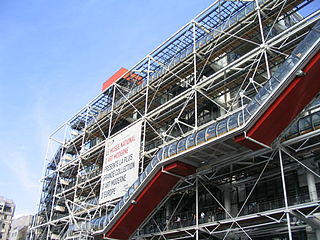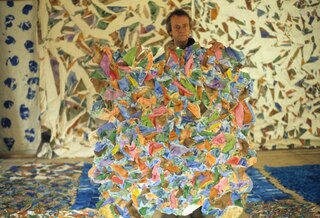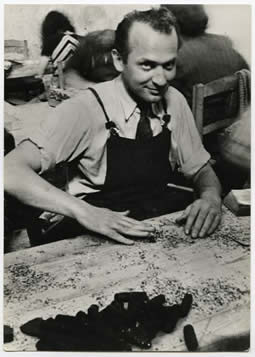
Wassily Wassilyevich Kandinsky was a Russian painter and art theorist. Kandinsky is generally credited as one of the pioneers of abstraction in western art. Born in Moscow, he spent his childhood in Odessa, where he graduated from Odessa Art School. He enrolled at the University of Moscow, studying law and economics. Successful in his profession, he was offered a professorship at the University of Dorpat. Kandinsky began painting studies at the age of 30.

Abstract art uses visual language of shape, form, color and line to create a composition which may exist with a degree of independence from visual references in the world.

Robert Delaunay was a French artist of the School of Paris movement; who, with his wife Sonia Delaunay and others, co-founded the Orphism art movement, noted for its use of strong colours and geometric shapes. His later works were more abstract. His key influence related to bold use of colour and a clear love of experimentation with both depth and tone.

The Musée National d'Art Moderne is the national museum for modern art of France. It is located in the 4th arrondissement of Paris and is housed in the Centre Pompidou. In 2021 it ranked 10th in the list of most visited art museums in the world, with 1,501,040 visitors. It is one of the largest museums for modern and contemporary art in the world.

Simon Hantaï is a painter generally associated with abstract art.

The Painter and His Model is a work by Henri Matisse painted late 1916, early 1917. It is currently in the collection of the Musée National d'Art Moderne, Centre Georges Pompidou, Paris. In this work Matisse depicted himself in his studio on the fourth floor of 19 Quai Saint-Michel, at work on his painting Laurette in a Green Robe (1916).

Henri Clément Serveau, also known as Clément-Serveau, was a French painter, designer, engraver and illustrator. Clément-Serveau produced works in a realist manner early on, but soon became interested in the new movements. He was influenced by his friend Louis Marcoussis and experimented with Cubism, utilising geometric patterns to give the illusion of form and space. Later in his career, he turned toward abstraction with a post-cubist stance. He designed banknotes for the Banque de France, produced large murals and participated in numerous French and international exhibitions.

Georges Valmier was a French painter. His work encompassed the great movements in the modern history of painting, starting with Impressionism in his early years, then Cubism which he discovered when he was around 25 years old, and finally Absstractionism from 1921. He also designed sets and costumes for theater and ballet, and models for fabrics, carpets, and other objects. His oil paintings do not exceed 300 in number, since Valmier died prematurely at the age of 51. His paintings were the culmination of many preparatory drafts in gouaches, multiple versions of which are works in themselves and reflect his penchant for colors and inventive shapes. Valmier was also a musician. He performed the works of Debussy, Ravel, Fauré, and Satie at major concerts and in churches, and had a decisive influence on the career of André Jolivet.

Albert Jean Gorin was a French neoplastic painter and constructive sculptor. He was a disciple of Piet Mondrian, and remained true to the concept of rigid geometricism and use of primary colors, but pushed the limits of neoplasticism by introducing circles and diagonals. He was known for his three-dimensional reliefs.
The Kandinsky Library is a library of 20th and 21st century visual arts located at the Pompidou Centre in Paris, France. It also serves as the Documentation and Research Centre of the French National Museum of Modern Art.

Woman with Black Glove is a painting by the French artist, theorist and writer Albert Gleizes. Painted in 1920, after returning to Paris in the wake of World War I, the paintings highly abstract structure is consistent with style of experimentation that transpired during the second synthetic phase of Cubism, called Crystal Cubism. As other post-wartime works by Gleizes, Woman with Black Glove represents a break from the first phase of Cubism, with emphasis placed on flat surface activity and large overlapping geometric planes.

Carmen Lydia Đurić, known by her artist name Hessie, was a Cuban textile artist who lived in France from 1962 until her death. Her creative work was mainly focused on embroidery using fabrics, although she also used the technique of collage with waste materials.

Jacques Hérold was a prominent surrealist painter born in Piatra Neamț, Romania.

Caoutchouc is a painting created circa 1909 by the French artist Francis Picabia. At the crossroads of Cubism and Fauvism, Caoutchouc is considered one of the first abstract works in Western painting. The painting is in the collection of Centre Pompidou, Musée National d'Art Moderne, in Paris.

Landscape with Red Spots was the name given to each of two successive oil paintings produced in Bavaria in 1913 by the Russian émigré painter Wassily Kandinsky. The first is now in the Museum Folkwang, in Essen, Germany. The second, known as Landscape with Red Spots, No 2, is in the Peggy Guggenheim Collection, in Venice.

Upward is an oil on cardboard painting created in 1929 by the Russian abstract painter Wassily Kandinsky. Painted at a time when Kandinsky was teaching art at the Bauhaus in Dessau, Germany, it now forms part of the Peggy Guggenheim Collection in the Palazzo Venier dei Leoni, Venice, Italy.

Three Elements is a March 1925 abstract painting by the Russian artist Wassily Kandinsky.

Jean Degottex was a French abstract painter, known in particular for his initial proximity with the lyrical abstraction movement of the 1950s and 1960s. He is considered an important artist of the abstraction movement in the second half of the twentieth century and a significant inspiration for contemporary art. Degottex was particularly inspired by East Asian calligraphy and Zen philosophy in achieving the erasure of the creative subject.
Composition with Three Figures is an oil on canvas painting by French painter Fernand Léger, from 1932. It is held at the Musée National d'Art Moderne, in Paris.

















